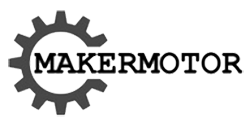
Makermotor
Makermotor offers a wide range of motors and controls tailored for the maker community, renowned for our swift shipping of readily available items.
Motors - AC, DC
Results:
3
Series
Voltage - Rated
Torque - Rated (oz-in / mNm)
Diameter - Shaft
Size / Dimension
RPM
Power - Rated
Motor Type
Operating Temperature
Termination Style
Encoder Type
Mounting Hole Spacing
Length - Shaft and Bearing
Function
Type
Torque - Max Momentary (oz-in / mNm)
Features
Gear Reduction Ratio
Results remaining:3
Applied Filters:
Makermotor
About Motors - AC, DC
AC and DC motors are electromechanical devices that convert electrical energy into mechanical motion or vibration. These motors are widely used in various applications where precise control over movement is required. Brushed DC motors are one of the most common types of motors. They consist of a rotor (also known as an armature), a stator, and brushes that make contact with the commutator. When a current is applied to the brushes, it creates a magnetic field that interacts with the permanent magnets on the rotor, causing it to rotate. Brushless DC motors, on the other hand, eliminate the need for brushes and commutators. Instead, they use electronic controllers to switch the direction of current flow in the stator windings, creating a rotating magnetic field that drives the rotor. Brushless DC motors offer advantages such as higher efficiency, longer lifespan, and reduced maintenance. Stepper motors are often used in applications that require precise positioning. They divide a full rotation into a series of steps, allowing for accurate control over angular displacement. Stepper motors can be controlled in open-loop or closed-loop systems, providing excellent control accuracy. Linear actuators are devices that produce linear motion. They are commonly used in applications that require controlled movement along a straight line. Linear actuators can be driven by AC or DC motors, and they can provide precise and repeatable linear motion. Servo motors are widely used in industrial automation and hobbyist applications. They offer high torque and speed control capabilities. Servo motors use feedback control systems to achieve accurate position, velocity, and torque control. They are commonly found in robotics, CNC machines, and remote-controlled vehicles. Vibration generating motors are specialized motors used in haptic applications, such as in smartphones, gaming controllers, and wearable devices. These motors create vibrations or vibrations with variable intensities, providing tactile feedback to the user. In summary, AC and DC motors are electromechanical devices that convert electrical energy into mechanical motion or vibration. This family includes brushed and brushless DC motors, stepper motors, linear actuators, servo motors, and vibration generating motors. Each type of motor has its own unique characteristics and is suitable for specific applications that require precise control over movement or vibration.



